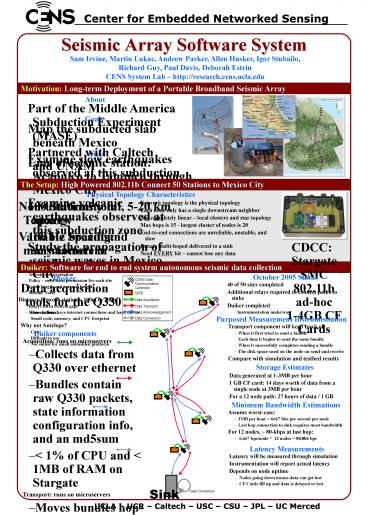Seismic Array Software System PowerPoint PPT Presentation
1 / 1
Title: Seismic Array Software System
1
Seismic Array Software System
Center for Embedded Networked Sensing
Sam Irvine, Martin Lukac, Andrew Parker, Allen
Husker, Igor Stubailo, Richard Guy, Paul Davis,
Deborah Estrin CENS System Lab
http//research.cens.ucla.edu
Motivation Long-term Deployment of a Portable
Broadband Seismic Array
About
- Part of the Middle America Subduction Experiment
(MASE) - Partnered with Caltech and UNAM
Goals
- Map the subducted slab beneath Mexico
- Examine slow earthquakes observed at this
subduction zone - Examine volcanic earthquakes observed at this
subduction zone - Study the propagation of seismic waves in Mexico
City
Needs
- Line of seismic station Acapulco to Tampico
through Mexico City - 100 Stations total, 5-20 km apart
- 100 Hz broadband seismometers
The Setup High Powered 802.11b Connect 50
Stations to Mexico City
Physical Topology Characteristics
- Non-uniformity in Topology
- Variable Spacing many factors in choosing a site
- Terrain and vegetation
- Policy need local permission for each site
- Cable length and antenna height
- Seismic Noise
- Distance between stations 100m to 20km
- Relays fill in critical gaps
- Some stations have internet connections and hard
drives
- Network topology is the physical topology
- Each node only has a single downstream neighbor
- Not completely linear local clusters and star
topology - Max hops is 15 - largest cluster of nodes is 20
- End-to-end connections are unreliable, unstable,
and slow - Data is multi-hoped delivered to a sink
- Need EVERY bit cannot lose any data
- CDCC StargateSMC 802.11b ad-hoc1-4GB CF Cards
Duiker Software for end to end system
autonomous seismic data collection
October 2005 Status
Duiker
CENS DataCommunicationController
- Data acquisition tools for the Q330
- Runs in linux
- Small code, memory, and CPU footprint
- Why not Antelope?
- Cost!
- Difficult to use
- Not suited for small embedded platform
- 40 of 50 sites completed
- Additional relays required to connect paths to
sinks - Duiker completed
- Instrumentation underway
Q330
Data Acquisition
Data Transport
Data Acknowledgement
Purposed Measurement Instrumentation
Data Conversion
- Transport component will keep track of
- When it first tried to send a bundle
- Each time it begins to send the same bundle
- When it successfully completes sending a bundle
- The disk space used on the node on send and
receive - Compare with simulation and testbed results
Duiker components
- Acquisition runs on microservers
- Collects data from Q330 over ethernet
- Bundles contain raw Q330 packets, state
information configuration info, and an md5sum - lt 1 of CPU and lt 1MB of RAM on Stargate
- Transport runs on microservers
- Moves bundles hop-by-hop to a sink
- Bundles transferred over tcp using scp
- Storage priority given to local bundles
- Data Acknowledgement
- Initiated at the sink
- List of received files at sink updated throughout
network - Each node uses list to delete files
- Old local bundles that are not acked are resent
- Data Conversion runs at the sink
- Converts bundles into miniseed format
- No conversion happens on Stargate
- Allows recovery from conversion errors since all
raw packets from Q330 are saved
Storage Estimates
- Data generated at 1-3MB per hour
- 1 GB CF card 14 days worth of data from a single
node at 3MB per hour - For a 12 node path 27 hours of data / 1 GB
Minimum Bandwidth Estimations
- Assume worst-case
- 3MB per hour 6667 bits per second per node
- Last hop connection to sink requires most
bandwidth - For 12 nodes, 80-kbps at last hop
- 6,667 bps/node 12 nodes 80,004 bps
Latency Measurements
- Latency will be measured through simulation
- Instrumentation will report actual latency
- Depends on node uptime
- Nodes going down means data can get lost
- CF Cards fill up and data is delayed or lost
Sink
Data Conversion
UCLA UCR Caltech USC CSU JPL UC
Merced

